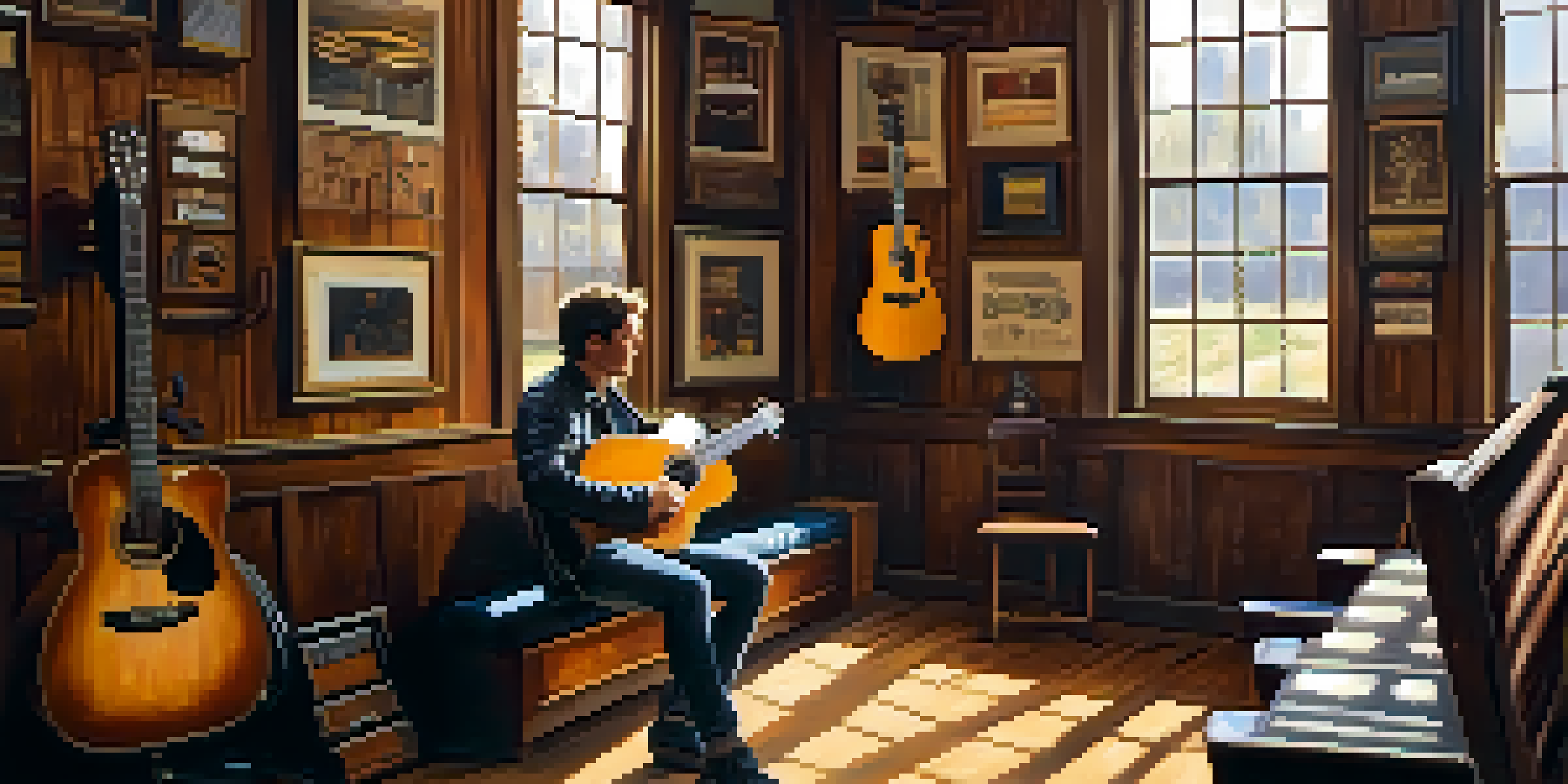How to Choose the Right Guitar for Ensemble Settings

Understand Your Ensemble's Musical Style and Needs
Before selecting a guitar, it’s crucial to grasp the musical style of your ensemble. Different genres often require specific tones and techniques, so knowing whether you're playing jazz, rock, or classical can significantly influence your choice. For example, a jazz ensemble might benefit from a hollow-body guitar that offers a warm, resonant sound.
A guitar is more than just a tool; it's an extension of your heart and soul.
Consider the role your guitar will play within the group. Will you be taking lead solos, or will you be providing rhythm? A solid-body electric guitar can cut through the mix for solos, while an acoustic guitar might blend beautifully for rhythm sections. This understanding will guide you in making a more informed decision.
Lastly, communicate with your fellow musicians about their preferences and the overall sound they envision. Collaborative discussions can help identify the best fit for everyone involved. After all, the goal is to create a harmonious blend that showcases all instruments effectively.
Explore Different Guitar Types and Their Features
Guitars come in various types, each with unique characteristics that can influence your sound in ensemble settings. Acoustic guitars, for instance, are great for folk and casual gatherings, while electric guitars excel in louder environments. Understanding the pros and cons of each can help you pick the right one.

Consider the body style of the guitar as well. A dreadnought acoustic produces a powerful sound, making it suitable for singer-songwriters, while a smaller-bodied guitar can offer a more focused tone for intricate fingerpicking. Each shape impacts projection and tone, so visualize how you want your sound to fit with the ensemble.
Know Your Ensemble's Style
Understanding your ensemble's musical genre and the role of your guitar is crucial for making an informed selection.
Don’t forget about the hardware! Features like pickups in electric guitars or the type of strings used can greatly affect your tone and playability. For instance, a guitar with dual humbucker pickups can provide a thicker sound, ideal for rock bands. Explore options that align with your musical vision.
Assess Your Skill Level and Comfort
Your skill level plays a significant role in selecting the right guitar for ensemble settings. If you're a beginner, opting for a model that's easier to play can boost your confidence and enjoyment. A guitar with a slimmer neck or lower action can make a world of difference in comfort, especially during long rehearsals.
The beautiful thing about learning is that no one can take it away from you.
Consider how much time you’ll spend with the instrument. If you’re planning to play regularly in a group setting, investing in a quality guitar that feels good in your hands is essential. It’s not just about the price tag; it’s about how the guitar inspires you to practice and perform.
Lastly, don’t shy away from trying out different guitars before making a decision. Visiting a local music store allows you to feel the weight, balance, and overall playability of various models. Find a guitar that resonates with you, both physically and emotionally.
Choose the Right Accessories for Ensemble Play
Accessories may seem like an afterthought, but they can significantly impact your performance in an ensemble. For instance, a good quality strap can help you maintain comfort during long sessions, while a reliable tuner ensures you’re always in tune with your fellow musicians. These small details help create a more seamless playing experience.
Consider also the type of amplifier you'll use if you're playing an electric guitar. Different amps can shape your sound, and some may suit your ensemble’s needs better than others. A tube amp, for example, often delivers a warm tone that works well in a band setting, while a solid-state amp might provide more versatility.
Test Multiple Guitars First
Taking the time to try out various guitars helps you find the one that feels right and complements your playing style.
Lastly, don’t overlook the importance of a decent case or gig bag. Protecting your guitar during transport is crucial, especially when moving between rehearsals or performances. A sturdy case ensures your instrument remains in top condition, ready to deliver its best sound each time you play.
Evaluate Your Budget Without Compromising Quality
Budgeting is a necessary part of the guitar selection process. Establish a range that feels comfortable for you, balancing quality with affordability. While it’s tempting to go for the cheapest option, remember that a quality instrument can make a significant difference in your overall experience and sound.
Look for brands that offer great value within your price range. Many manufacturers produce solid, reliable guitars without breaking the bank. For example, brands like Yamaha and Squier provide excellent entry-level options that sound fantastic in ensemble settings.
Finally, consider buying used or refurbished guitars. These options often provide significant savings while still delivering quality performance. Just be sure to inspect the instrument thoroughly to ensure it’s in good playing condition, as a little wear can sometimes lead to a great deal!
Test Drive Multiple Guitars Before Deciding
Never underestimate the power of a test drive! When selecting a guitar for ensemble play, take the time to try out multiple options. This hands-on experience allows you to feel the differences in weight, playability, and sound, helping you narrow down your choices effectively.
Play different styles and techniques to see how each guitar responds. Strumming chords, playing melodies, or even fingerpicking can reveal how well the guitar suits your playing style and preferences. This practical approach gives you a sense of how the guitar will perform in a live ensemble setting.
Seek Guidance from Musicians
Consulting experienced musicians for recommendations can provide valuable insights and lead you to the perfect guitar.
If possible, play alongside other musicians during your test drive. Hearing how the guitar interacts with other instruments will provide valuable insight into its suitability for ensemble work. Ultimately, you want a guitar that not only feels right but also complements your musical community beautifully.
Consult Experienced Musicians for Recommendations
Don’t hesitate to seek advice from experienced musicians when choosing a guitar for ensemble settings. They often have valuable insights and can suggest models based on their own experiences. Whether it’s a mentor, teacher, or fellow band member, tapping into their knowledge can be incredibly beneficial.
Ask about their favorite guitars and why they work well in group settings. Sometimes, personal anecdotes about specific models can reveal hidden gems that might not be on your radar. Plus, recommendations from trusted sources can lead you to explore options you may not have considered otherwise.

Additionally, joining online forums or local music groups can connect you with a broader community of musicians. Engaging in discussions can help you gather diverse opinions and experiences, ensuring you make an informed decision that aligns with your ensemble's needs.
Trust Your Instincts and Enjoy the Process
Choosing the right guitar should be an enjoyable journey rather than a stressful task. Trust your instincts throughout the process; if a particular guitar speaks to you, it’s likely the right choice. Your connection to the instrument matters, especially when you’re playing with others.
Embrace the exploration phase! Experiment with various styles, designs, and sounds. Enjoying the process can lead to discovering unexpected favorites and help you develop your unique musical identity within the ensemble.
Remember, the ultimate goal is to find a guitar that not only fits your ensemble's sound but also inspires you personally. So, dive into your search with an open heart and a sense of adventure—your perfect guitar is waiting to be found!